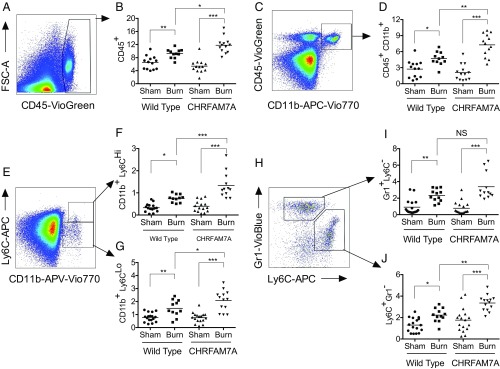Fig. 5.
CHRFAM7A increases myeloid migration to lung after burn injury with a bias toward monocyte lineage. Flow cytometric analyses of enzymatically digested lung cells were obtained from mice 4 h after a 7-s thermal injury to show that, after the exclusion of debris, doublets, and nonviable cells (SI Appendix, Fig. S10), different myeloid immunophenotypes can be distinguished, identified, and quantified. As such, total CD45+ staining leukocytes (A and B), CD45+CD11b+ monocytes (C and D), and CD11b+Ly6CHigh/Low inflammatory/patrolling monocytes (E–G) are all significantly increased in lung after burn injury in both wild-type and CHRFAM7A-transgenic mice. Whereas basal percentages are not qualitatively different, there is a significantly increased quantitative response in lungs of CHRFAM7A mice to the burn injury in CD45+ staining leukocytes (B, P < 0.05), CD45+CD11b+ monocytes (D, P < 0.05), and CD11b+Ly6CHigh/Low inflammatory/patrolling monocytes (F, P < 0.001; G, P < 0.05). In contrast, the percentage of Gr1+Ly6C− granulocytes (H and I) increased in response to burn injury (P < 0.05) but there was no effect of CHRFAM7A. The Ly6C+Gr1− monocyte population, however (H and J), is similarly increased by burn (P < 0.05) but further increased (P < 0.01) in lungs of CHRFAM7A-transgenic mice. Differences between the groups were analyzed using one-way ANOVA (*P < 0.05, **P < 0.01, ***P < 0.001).

